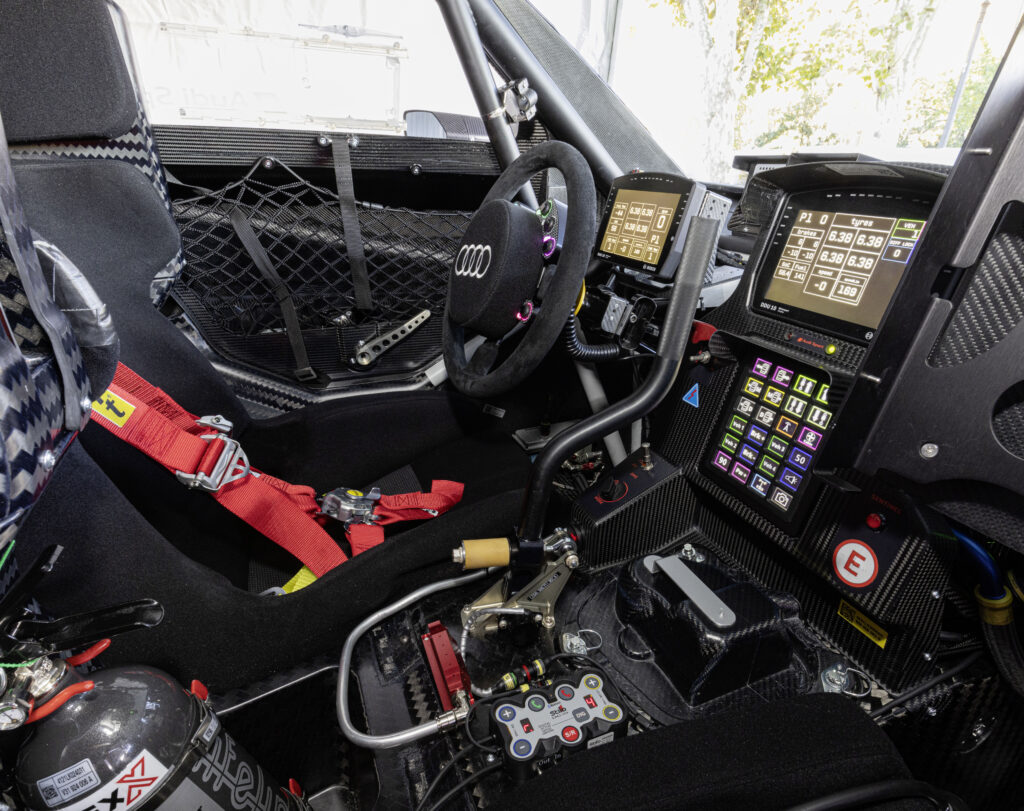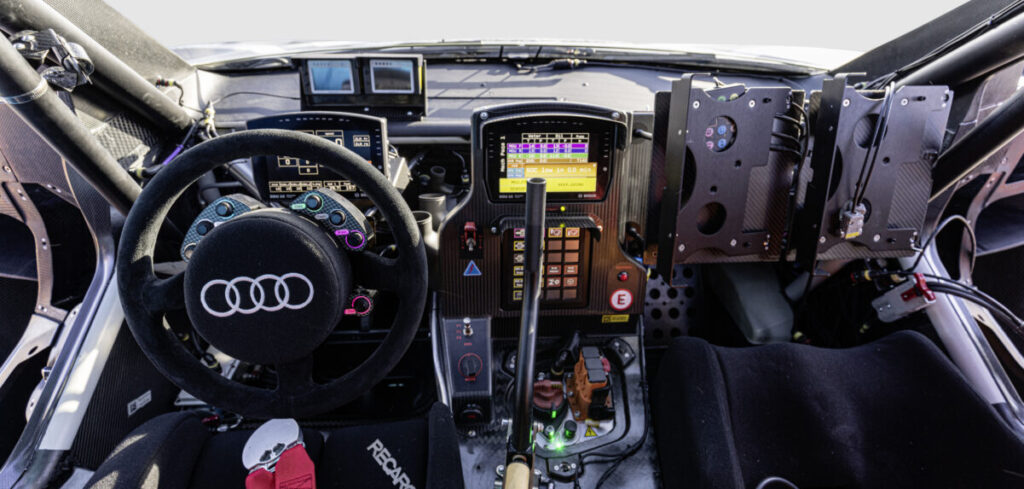The cockpit design of a Dakar off-road racer is shaped by the demands of crossing thousands of kilometers of desert terrain, and Audi Sport has provided details of some of the tools it is providing its drivers and co-drivers in the hybrid RS Q e-tron.
Audi points out that in the past, there was a clear division of tasks in cross-country rallying: the driver driving, the co-driver navigating. These roles have long since changed: with the old paper roadbook now in digital form, there has been a redistribution of jobs between driver and co-driver with the latter now responsible for monitoring the majority of vehicle systems in addition to navigation.
The driver controls
For Audi’s drivers, there is no longer a need to change gear thanks to the electric powertrain (the IC engine is purely a range extender) and beyond a throttle and brake pedal, the only other control is a handbrake.
There are eight control buttons on the steering wheel, operating functions such as the horn and windshield wipers, as well as one executing data entries in the software if the driver wants to store an anomaly with a time stamp in the logger memory. There is also a speed limiter which can be activated in zones where a maximum speed is prescribed.
Behind the steering wheel sits a display directly in the driver’s lower field of vision. This provides information on tire pressures, whether forward or reverse drive is selected, and speed. It flashes up important warnings so that the driver can react immediately in the event of an imminent system shutdown, or disconnection of the high-voltage battery, for example. Two small displays mounted above and toward the windshield bring essential information into the driver’s field of vision: a so-called repeater on the left shows the compass direction, while the display on the right shows vehicle speed.
A central display sits between the driver and co-driver and is the main access point for information on tire pressures, the selected brake balance, the brake-by-wire system and all other vehicle functions. Information is displayed in green when a function or system is working properly, or in red when an error occurs.
A switch panel is located underneath this central display. Its individual keys are touch-sensitive with a haptic feedback. The touchpad has 24 programable keys allowing selection of, for example, preselected maximum speeds, or operation of the air-conditioning system. Different pages on the display can be scrolled through and the keypad programmed to assign different button functions depending on the screen selected. For example, less frequently used functions can be called up by scrolling through the screens, or in the event of damage, individual systems can be switched off or into failsafe mode.
 Operation of the switch panel is the responsibility of the co-driver; the driver only tells them what information they would like displayed. The co-driver thus assumes a high level of responsibility in addition to their original main task – navigation. “I now spend only half my energy on navigation, the other half on operating the car. But I love this new challenge,” said Edouard Boulanger, Audi driver Stéphane Peterhansel’s co-driver.
Operation of the switch panel is the responsibility of the co-driver; the driver only tells them what information they would like displayed. The co-driver thus assumes a high level of responsibility in addition to their original main task – navigation. “I now spend only half my energy on navigation, the other half on operating the car. But I love this new challenge,” said Edouard Boulanger, Audi driver Stéphane Peterhansel’s co-driver.
Navigation aids
In the past, the roadbooks for an upcoming day would be issued the night before. However, now, teams only receive the digital route book 15 minutes before stage start. The short-notice information on the route as well as the switch to a digital roadbook format poses major challenges for co-drivers.
In the RS Q e-tron, the co-drivers have two tablet screens that replace the previous paper roadbooks, operated by two remote controls connected by cables. On the screen on the left, the roadbook shows the route through terrain, and only if this tablet should fail are the crews allowed to open and use the sealed paper roadbook supplied, otherwise they face a penalty.
The tablet on the right contains the GPS navigation system and validates the digital waypoints that each participant must drive to. When the car reaches the radius of a waypoint, the driver is also shown direction arrows via a display below the windshield. However, the GPS does not plot out an exact route in the way a road car would. It provides information such as a compass bearing and distance to waypoints, and it remains up to the driver to pick their way through the terrain as it is presented (the GPS is also used by the organizers to monitor route or speed infringements).
The final irreplaceable element of the cockpit is the Iritrack system in the center console. This allows the organizer to monitor vehicle speed and current position and can detect possible accidents. In the event of an emergency, the co-driver can use it to inform the organizer directly whether the crew are uninjured, whether they require medical assistance or whether the rescue team should help another participant who has had an accident.



